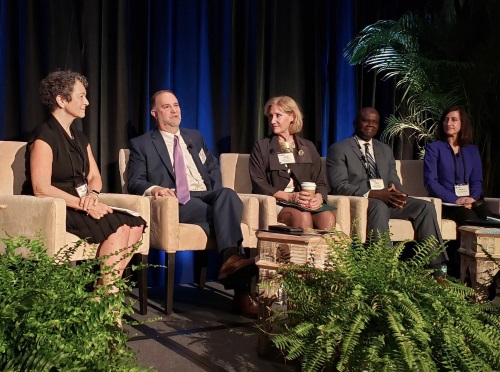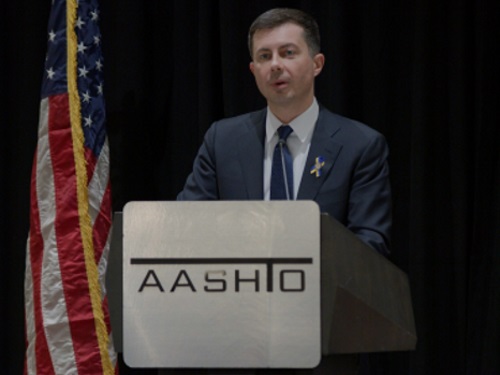The role of a state department of transportation in developing and managing a multimodal transportation network has evolved “significantly” away from their 100-year-old roots as builders of the national highway system to one focused on managing existing assets and operations, connecting communities, and providing innovative mobility programs and services.
[Above photo by AASHTO]
Yet state DOTs need to find ways to “tell the story” about that transition more effectively, especially as a way to connect them to the communities they serve, explained Paula Hammond, market leader-multimodal at consulting firm WSP USA and a former secretary of the Washington State Department of Transportation.

“We have talked quite a bit about IIJA implementation and understating the depth and breadth of what state DOTs are working on. Yet we are not telling the story about that work often enough or well enough,” she said during a “knowledge session” sponsored by WSP USA during the American Association of State Highway and Transportation Officials 2022 Washington Briefing on March 2.
“We need to highlight the challenges, opportunities, and diversity of the work state DOTs are doing,” Hammond noted as moderator of a session’s panel discussion. “As we work on demonstrating the value of transportation, also remember that state DOTs are working hard to transform current transportation systems into 21st century systems. State DOTs are charting that course.”
Julie Lorenz, secretary of the Kansas Department of Transportation, stressed that it is “important that we pause” as state DOTs and determine “what we are trying to achieve for the American public. This is not to say state DOTs can do everything – but we need to make clear to the American public what state DOTs can do to modernize and make transportation better.”

Lorenz noted that, “our industry is fairly unsophisticated when it comes to market research; there are things to learn from other industries so we can expand and improve our connections with the public.”
She added that “telling the story” about transportation is not always about focusing on large projects – or even focusing on “projects” at all.
“Take building sidewalks: They represent a tiny part of our budgets but have a huge impact livability – they are literally a first/last mile issue,” Lorenz explained. “But they are also about solving mobility issues for our communities. It’s about bringing the problems we need to solve in to us – not the projects themselves.”
Nancy Daubenberger, deputy commissioner and chief engineer for the Minnesota Department of Transportation, said that is part of “addressing the future vision of transportation for the communities affected by it – and we need to communicate that vision.”

She said it is about considering the health impacts and “livability framework” of transportation projects going forward. “We need to share the power of decision making with those impacted by our projects and understand how the transportation system can better support them,” Daubenberger noted.
Paul Ajegba, director of the Michigan Department of Transportation, said that is why state DOTs must use a multimodal focus going forward.
“We need to coordinate bridge and road work with active transportation needs – we must align the programs,” he explained. “Walking and bicycling are things we didn’t use to think about when it came to managing [transportation] assets. There is also a positive public health dimension to this, when we can encourage walking. So going forward it is about how we make sure modal choice is available.”

Another key part of the multimodal communication puzzle relies on building better connections between state DOTs and state legislators, noted Eric Boyette, secretary of the North Carolina Department of Transportation.
“For example, we need to look at the now and the future when comes to infrastructure resiliency – we really have to plan and prepare infrastructure to survive 100-year storms. But we must also budget for it,” he explained.
“That is why communication with our legislators so important,” Boyette said. “We need to make sure they not only understand what we are doing, but show them we understand what they are doing; especially when it comes to budgeting.”



